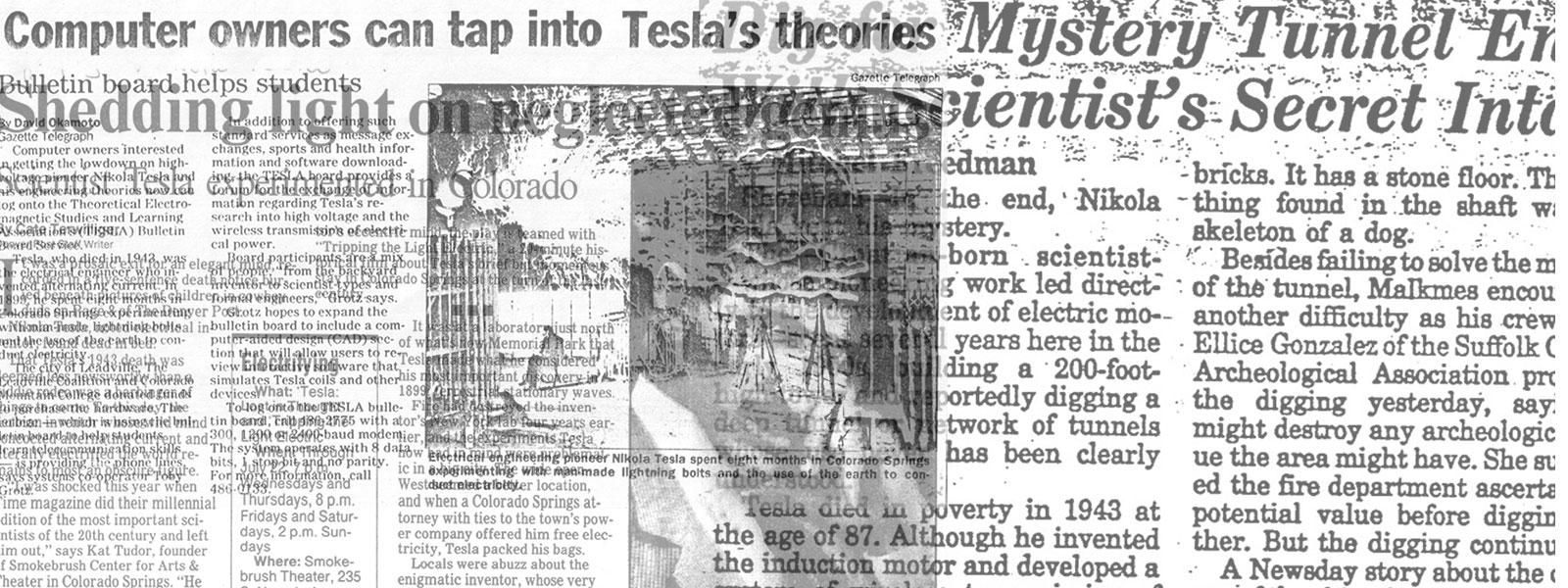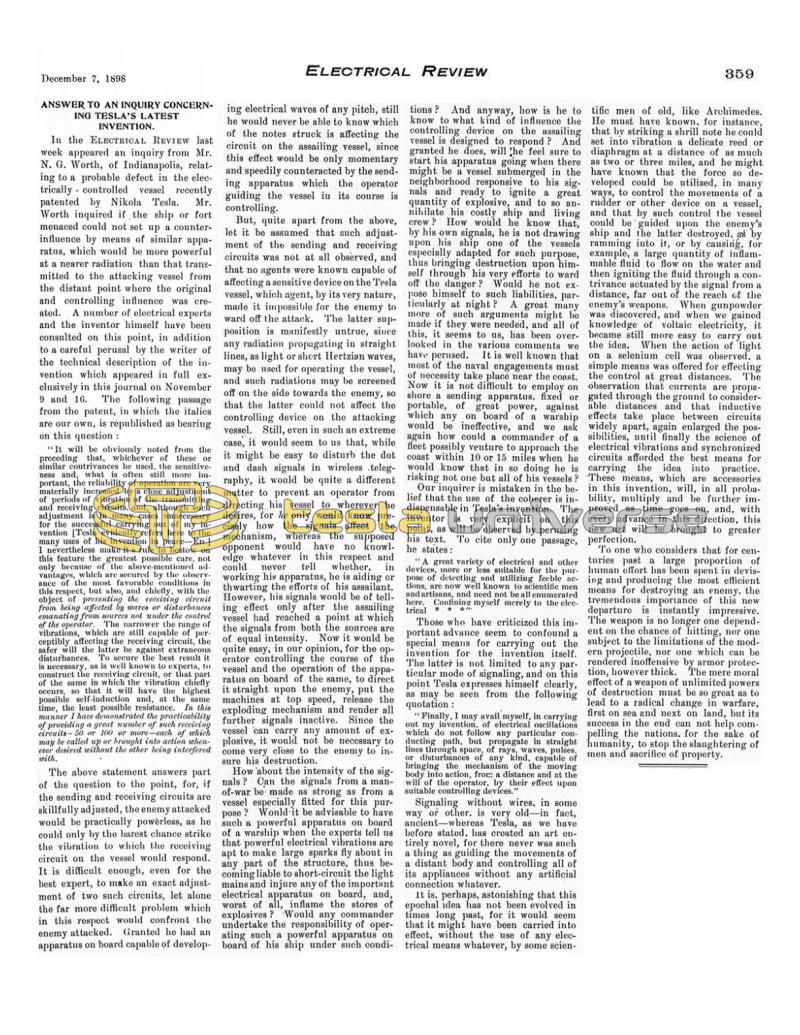
Nikola Tesla Articles
Answer to an Inquiry Concerning Tesla's Latest Invention
In the Electrical Review last week appeared an inquiry from Mr. N. G. Worth, of Indianapolis, relating to a probable defect in the electrically - controlled vessel recently patented by Nikola Tesla. Mr. Worth inquired if the ship or fort menaced could not set up a counterinfluence by means of similar apparatus, which would be more powerful at a nearer radiation than that transmitted to the attacking vessel from the distant point where the original and controlling influence was created. A number of electrical experts and the inventor himself have been consulted on this point, in addition to a careful perusal by the writer of the technical description of the invention which appeared in full exclusively in this journal on November 9 and 16. The following passage from the patent, in which the italics are our own, is republished as bearing on this question :
“It will be obviously noted from the preceding that, whichever of these or similar contrivances be used, the sensitiveness and, what is often still more important, the reliability of operation are very materially increased by a close adjustment of periods of vibration of the transmitting and receiving circuits, and, although such adjustment is in many cases unnecessary for the successful carrying out of my invention [Tesla evidently refers here to the many uses of his invention in peace - Ed.] I nevertheless make it a rule to bestow on this feature the greatest possible care, not only because of the above-mentioned advantages, which are secured by the observance of the most favorable conditions in this respect, but also, and chiefly, with the object of preventing the receiving circuit from being affected by waves or disturbances emanating from sources not under the control of the operator. The narrower the range of vibrations, which are still capable of perceptibly affecting the receiving circuit, the safer will the latter be against extraneous disturbances. To secure the best result it is necessary, as is well known to experts, to construct the receiving circuit, or that part of the same in which the vibration chiefly occurs, so that it will have the highest possible self-induction and, at the same time, the least possible resistance. In this manner I have demonstrated the practicability of providing a great number of such receiving circuits - 50 or 100 or more - each of which may be called up or brought into action whenever desired without the other being interfered with.
The above statement answers part of the question to the point, for, if the sending and receiving circuits are skillfully adjusted, the enemy attacked would be practically powerless, as he could only by the barest chance strike the vibration to which the receiving circuit on the vessel would respond. It is difficult enough, even for the best expert, to make an exact adjustment of two such circuits, let alone the far more difficult problem which in this respect would confront the enemy attacked. Granted he had an apparatus on board capable of developing electrical waves of any pitch, still he would never be able to know which of the notes struck is affecting the circuit on the assailing vessel, since this effect would be only momentary and speedily counteracted by the sending apparatus which the operator guiding the vessel in its course is controlling.
But, quite apart from the above, let it be assumed that such adjustment of the sending and receiving circuits was not at all observed, and that no agents were known capable of affecting a sensitive device on the Tesla vessel, which agent, by its very nature, made it impossible for the enemy to ward off the attack. The latter supposition is manifestly untrue, since any radiation propagating in straight lines, as light or short Hertzian waves, may be used for operating the vessel, and such radiations may be screened off on the side towards the enemy, so that the latter could not affect the controlling device on the attacking vessel. Still, even in such an extreme case, it would seem to us that, while it might be easy to disturb the dot and dash signals in wireless telegraphy, it would be quite a different matter to prevent an operator from directing his vessel to wherever he desires, for he only would know precisely how the signals affect the mechanism, whereas the supposed opponent would have no knowledge whatever in this respect and could never tell whether, in working his apparatus, he is aiding or thwarting the efforts of his assailant. However, his signals would be of telling effect only after the assailing vessel had reached a point at which the signals from both the sources are of equal intensity. Now it would be quite easy, in our opinion, for the operator controlling the course of the vessel and the operation of the apparatus on board of the same, to direct it straight upon the enemy, put the machines at top speed, release the exploding mechanism and render all further signals inactive. Since the vessel can carry any amount of explosive, it would not be necessary to come very close to the enemy to insure his destruction.
How about the intensity of the signals? Can the signals from a man-of-war be made as strong as from a vessel especially fitted for this purpose ? Would it be advisable to have such a powerful apparatus on board of a warship when the experts toll us that powerful electrical vibrations are apt to make large sparks fly about in any part of the structure, thus becoming liable to short-circuit the light mains and injure any of the important electrical apparatus on board, and, worst of all, inflame the stores of explosives? Would any commander undertake the responsibility of operating such a powerful apparatus on board of his ship under such conditions? And anyway, how is he to know to what kind of influence the controlling device on the assailing vessel is designed to respond? And granted he does, will he feel sure to start his apparatus going when there might be a vessel submerged in the neighborhood responsive to his signals and ready to ignite a great quantity of explosive, and to so annihilate his costly ship and living crew? How would he know that, by his own signals, he is not drawing upon his ship one of the vessels especially adapted for such purpose, thus bringing destruction upon himself through his very efforts to ward off the danger? Would he not expose himself to such liabilities, particularly at night? A great many more of such arguments might be made if they were needed, and all of this, it seems to us, has been overlooked in the various comments we have perused. It is well known that most of the naval engagements must of necessity take place near the coast. Now it is not difficult to employ on shore a sending apparatus, fixed or portable, of great power, against which any on board of a warship would be ineffective, and we ask again how could a commander of a fleet possibly venture to approach the coast within 10 or 15 miles when he would know that in so doing he is risking not one but all of his vessels?
Our inquirer is mistaken in the belief that the use of the coherer is indispensable in Tesla’s invention. The inventor is very explicit on this point, as will be observed by perusing his text. To cite only one passage, he states:
“A great variety of electrical and other devices, more or less suitable for the purpose of detecting and utilizing feeble actions, are now well known to scientific men and artisans, and need not be all enumerated here. Confining myself merely to the electrical * * *”
Those who have criticized this important advance seem to confound a special means for carrying out the invention for the invention itself. The latter is not limited to any particular mode of signaling, and on this point Tesla expresses himself clearly, as may be seen from the following quotation:
“Finally, I may avail myself, in carrying out my invention, of electrical oscillations which do not follow any particular conducting path, but propagate in straight lines through space, of rays, waves, pulses, or disturbances of any kind, capable of bringing the mechanism of the moving body into action, from a distance and at the will of the operator, by their effect upon suitable controlling devices.”
Signaling without wires, in some way or other, is very old - in fact, ancient - whereas Tesla, as we have before stated, has created an art entirely novel, for there never was such a thing as guiding the movements of a distant body and controlling all of its appliances without any artificial connection whatever.
It is, perhaps, astonishing that this epochal idea has not been evolved in times long past, for it would seem that it might have been carried into effect, without the use of any electrical means whatever, by some scientific men of old, like Archimedes. He must have known, for instance, that by striking a shrill note he could set into vibration a delicate reed or diaphragm at a distance of as much as two or three miles, and he might have known that the force so developed could be utilized, in many ways, to control the movements of a rudder or other device on a vessel, and that by such control the vessel could be guided upon the enemy’s ship and the latter destroyed, as by ramming into it, or by causing, for example, a large quantity of inflammable fluid to flow on the water and then igniting the fluid through a contrivance actuated by the signal from a distance, far out of the reach of the enemy’s weapons. When gunpowder was discovered, and when we gained knowledge of voltaic electricity, it became still more easy to carry out the idea. When the action of light on a selenium cell was observed, a simple means was offered for effecting the control at great distances. The observation that currents are propagated through the ground to considerable distances and that inductive effects take place between circuits widely apart, again enlarged the possibilities, until finally the science of electrical vibrations and synchronized circuits afforded the best means for carrying the idea into practice. These means, which are accessories in this invention, will, in all probability, multiply and be further improved as time goes on, and, with every advance in this direction, this new art will be brought to greater perfection.
To one who considers that for centuries past a large proportion of human effort has been spent in devising and producing the most efficient means for destroying an enemy, the tremendous importance of this new departure is instantly impressive. The weapon is no longer one dependent on the chance of hitting, nor one subject to the limitations of the modern projectile, nor one which can be rendered inoffensive by armor protection, however thick. The mere moral effect of a weapon of unlimited powers of destruction must be so great as to lead to a radical change in warfare, first on sea and next on land, but its success in the end can not help compelling the nations, for the sake of humanity, to stop the slaughtering of men and sacrifice of property.
